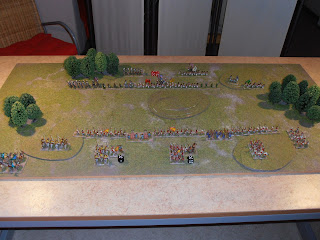I like this!
Today I tested irregular light horse (2
LH) and “raw” troops or militia (4Ms) using a big battle encounter. For this
test, I fielded 24 elements from the British-Indian collection to fight an
Imperial Chinese force of 36 elements.
Both sides divided their number into two
commands which gave the Chinese a slight advantage before reaching a
demoralized state. Die roll for general’s characteristic resulted in one Rash
commander and Bold CinC for the British and two Cautious generals for the
Imperial forces.
The Imperial army grouped all their cavalry
supported by an equal number of infantry and artillery (rockets). The
remaining infantry and artillery, under command of the CinC, were deployed in
line with three columns in support.
To counter the Chinese cavalry, the
British and Native cavalry were deployed on the right supported by a battalion of
Gurkha and cannon. The center was covered by two brigades with a third in
support and on the extreme left flank heavy artillery would offer support fire
from their hill position. Supporting the battery were two Sepoy battalions.
Turn 1
The British, as aggressor, moved their
center forward while the Gurkha on the right advanced on the Chinese infantry.
The Chinese responded with flank maneuvers. Half the irregular cavalry became
active encircling the British right while the Imperial
infantry on the right moved forward to pin the British.
Turn 2
Caught flat footed, the Gurkha were
re-deployed to deal with the encircling irregular horse while British and
Native cavalry moved forward to counter the Imperial advance.
The Imperial center held their initial
position while the right flank continued wheeling inward. An exchange of artillery fire delivered one Imperial casualty. Britain 1-0.
Turn 3 and 4
Now in effective musket range, the center of both sides exchange volleys producing gaps which were quickly re-formed the
following bound. The British Rifle brigade had the worst of an exchange losing an
element and having another flee. On the British right, the Gurkha bested both irregular
horse in successive turns.
Turn 5
The British cavalry emboldened by the Gurkha success were able to deliver a
similar result thereby demoralizing the Imperial left. Closing
to combat, British line and Native infantry experienced difficulties with the
longer reach of the Imperial spearmen. Unfortunately, the militia were less inclined to enjoy the dance and recoiled or left the field all together.
By turn 6, the game was up and the
Imperial troops had enough.
Notes.
Militia, musket armed troops (4Ms) have
similar factors as shot (SH) under the current DBA-HX, but now retain a shooting range
similar to the British. This meant the Imperial muskets still needed maximum concentration to maintain a slight advantage while the British need not. The Imperial spear and skirmishers held
surprises for the British. A typical Imperial brigade comprised of 2 x 4Ms, 1 x 4Sp, 1 x 2Skm.
The irregular horse did use the + 1 for
rear support on one instance. This was done against the Gurkha and they paid dearly for it. It would be useful with
larger cavalry formations where such tactics could enjoy flank protection.
The advantage of troop type, British trained versus Imperial militia, was more than enough to offset the advantage of a dozen extra elements and outclassed by British command. Further testing will have the Imperial army with a sprinkling of trained troops and hordes of irregular types.
Cheers,






1 opmerking:
Thanks. If you should miss further developments, check the index to the right and scroll down to DBA-HX with 3.0.
We have four new comers with little interest in Ancients, but definitely for the Musket period.
Cheers, Robert
Een reactie posten